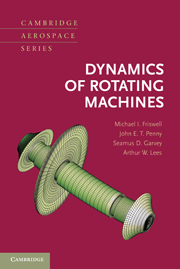Book contents
- Frontmatter
- Contents
- Preface
- Acronyms
- 1 Introduction
- 2 Introduction to Vibration Analysis
- 3 Free Lateral Response of Simple Rotor Models
- 4 Finite Element Modeling
- 5 Free Lateral Response of Complex Systems
- 6 Forced Lateral Response and Critical Speeds
- 7 Asymmetric Rotors and Other Sources of Instability
- 8 Balancing
- 9 Axial and Torsional Vibration
- 10 More Complex Rotordynamic Models
- Solutions to Problems
- Appendix 1 Properties of Solids
- Appendix 2 Stiffness and Mass Coefficients for Certain Beam Systems
- Appendix 3 Torsional Constants for Shaft Sections
- Bibliography
- Index
Appendix 2 - Stiffness and Mass Coefficients for Certain Beam Systems
Published online by Cambridge University Press: 05 February 2015
- Frontmatter
- Contents
- Preface
- Acronyms
- 1 Introduction
- 2 Introduction to Vibration Analysis
- 3 Free Lateral Response of Simple Rotor Models
- 4 Finite Element Modeling
- 5 Free Lateral Response of Complex Systems
- 6 Forced Lateral Response and Critical Speeds
- 7 Asymmetric Rotors and Other Sources of Instability
- 8 Balancing
- 9 Axial and Torsional Vibration
- 10 More Complex Rotordynamic Models
- Solutions to Problems
- Appendix 1 Properties of Solids
- Appendix 2 Stiffness and Mass Coefficients for Certain Beam Systems
- Appendix 3 Torsional Constants for Shaft Sections
- Bibliography
- Index
Summary
This appendix provides the stiffness coefficients of a shaft at a point along the shaft, which is typically a disk. These coefficients may be used in a simple two or four degrees of freedom model of a machine. The first column in Table A2.1 lists the boundary conditions for the shaft at the two bearing locations, which are at distances of a and b from the disk, for systems 1 through 5. A pinned-boundary condition forces the transverse displacement of the beam to be zero at the boundary but the beam is free to rotate. A clamped-boundary condition forces both the transverse displacement and the rotation of the beam to be zero at the boundary. If the boundary condition is free, then no constraints are applied. Generally, a beam is supported at the two ends and the boundary conditions are used to describe the beam system. For example, a clamped-free beam has one end clamped and the other free.
The stiffness matrices are obtained by a static reduction of the stiffness matrices (see Section 2.5.1), where the disk degrees of freedom are the master degrees of freedom. The stiffness matrix for each part of the shaft is equal to that obtained from the FEM, because a uniform beam with load applied only at the ends has its displacement defined by a cubic.
Table A2.2 lists the mass coefficients for systems 1 through 4 based on the displacement model given by the static deformation used to calculate the stiffness coefficients. These mass coefficients should be added to those of the disk to produce the equations of motion of the system.
- Type
- Chapter
- Information
- Dynamics of Rotating Machines , pp. 500 - 504Publisher: Cambridge University PressPrint publication year: 2010



